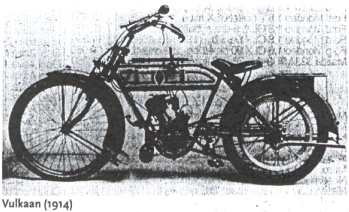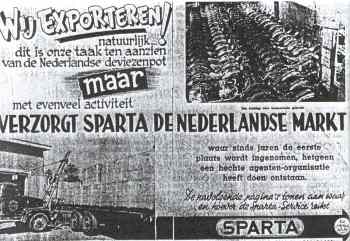One century of Dutch Glory
The first real Dutch motorcycle had 1 hp and was shown
on the exhibition of the Rijwiel Industrie (Cycle Industry) in Amsterdam,
the predecessor of the MotoRai. Roundabout 80 manufacturers have tried
their luck since then. A few with success. Finally it is owed to the
simple Spartamet (a motor-assisted pedal cycle) that our national history
of motorised two-wheelers has completed the 20th century.
The Dutch motorcycle producers had the same problem as
Fokker, Daf and Philips. Dutch people do not feel great enthusiasm for
home-grown products. Everything that comes from afar is, looks and tastes
better. In the dark corners of the mind, the Dutchman has always stayed
the sailor from the 17th century.
Despite this, tens of entrepreneurs have tried to found
a motorcycle brand. Sometimes with moderate success. That so much of all
these successful and failed attempts could be seen at the last MotoRai, is
the merit of early enthusiasts, who noticed in time that a piece of Dutch
history was rusting away on attics and in sheds. In the meantime the
interest in old motorcycles, mopeds and scooters has enormously increased.
The boys and girls who have been riding an Eysink, Sparta or Hulsmann in
the old days, have come to the age that nostalgia strikes. Furthermore
they have the time and money to convert melancholic feelings into a hobby.
The same holds also for brands from abroad.
"Until a few years ago motorcycles and mopeds were
often offered for free, as long as you came to pick them up", says
Hans van Dissel of the Foundation Historical Motor Documentation.
"Now much money is paid for them. Ten thousand guilders for a good
Royal Nord is no exception. It is madness, but it happens. And if the new
owner looks at his classic bike with warm feelings every day, he is quite
right too".

The exhibition "Dutch make" which could be
visited at the last MotoRai, consists for a large part of motorcycles,
mopeds and scooters beloning to private persons. They give an idea of 100
years of motorised two-wheelers from Dutch production. Also home and
abroad built sportsmachines of Dutch motorcyclists have been gathered,
like the Eysinck cross motorcycle of Simon Schram, the Laverda SFC of Hans
Hutten and the Triumph speedway motorcycle of Jaap Iesbers.
The Dutch motorcycle history is a parade of names that
now only shine in remembrance, like Gruno, De Hinde, Eysink, Otten,
Vulkaan, Sparta, Cyrus, Kaptein and Hulsmann. Some manufacturers have only
built a handful of motorcycles. Especially in the early years a lot of
entrepreneurs tried to set up a small motorcycle factory.
Most times only the frame was built in the Netherlands,
while the engine came from e.g. Germany or France. Around the turn of the
century, the firm Altena from Haarlem was the first manufacturer who
equipped his Dutch frame with a Dutch 4-stroke engine. The 2 hp Altena's
in 1904 even rode the 1300 km long reliability run Paris - Bordeaux -
Paris. Only 26 of the 60 participants reached the finish, amongst which an
Altena. This resulted in a nice (Dutch) advertisement - rhyme:
Do you know it already, this Dutch
made motorcycle,
That beat Frenchman, Belgian and Prussian, how courageous!
Dutchmen, show your patriotism
You'll show everyone your back if you ride this wheel
But the fame of Altena had vanished already a few years
later. In 1906 the production was stopped.
When Altena disappeared from the spotlights, brands
like Simplex and Eysinck took over. After the poor 20's the flowering 30's
came, because the crisis lead to a demand for cheap transport. Besides
this motorcycles lighter than 60 kilograms were exempted from tax.
Especially bicycle manufacturers tried to get a piece of the pie by
equipping their bicycles with an engine. In 1940 the party was over. It is
not possible to say that the Dutch motorcycle industry has had a large
share in the world-wide development of the motorcycle, although there were
some pretty nice inventions. A small, super strong 2-stroke from Lucas
Steenbergen, the engine constructions from Joop Carly and the crankless
rotation engine of Leo Kagie. To be honest, the foreigners built
motorcycles which were just a little nicer, more robust, and often cheaper
than the Dutch. One had to be very patriotic to buy such a motorcycle.

Increasing wealth and the coming up of affordable cars
put an end to the serious motorcycle industry at the end of the 50's. The
manufacturers of mopeds however had a good business because the youth
became mobile. The Berini "egg" is a well-known phenomenon for
many 50+ people. But in the 60's and 70's also this business fell off
because the Dutchmen again choose for mopeds and scooters from abroad.
Brands like Puch and Vespa produced what the youth
liked. There was some success for a short time for Jamathi and Van Veen,
but after that it became very quiet around the motorised 2-wheelers from
Dutch ground. At the end it is the virtue of the Spartamet that the 100th
anniversary was reached.
Read for you in the AD (newspaper) of 16 October 1999
(Translation: Paul Essens)
Information:
Stichting Historische Motor Documentatie
Snelliusstraat 11
2517 RG Den Haag
070-3650860
e-mail: motorhmr@xs4all.nl
website: www.motorrijwiel.nu
Top - Back to former page - Home |

